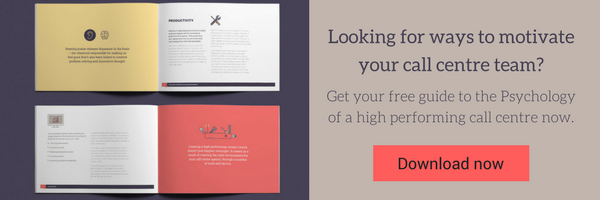Call centre benchmarks in a customer-centric business

Call centre benchmarks in a customer-centric business
A favourite metric in the call centre world is First Call Resolution. That old chestnut. High First Call Resolution means everyone is doing a good job, right? But what if the call is ‘resolved’, but the customer had been waiting on line for 20 minutes? Or because they were speaking to such a lacklustre call centre agent they were left feeling completely unexcited about your company – after all its staff sound like they’d rather be anywhere else. Sometimes meeting call centre benchmarks can mean that something else important has been missed.
Call centre benchmarks are changing, to bring expectations in line with the increasing focus on customer experience. This means call centre agents have KPIs that are in line with broader company priorities, like customer retention and acquisition. The challenge as a call centre manager is to adjust your call centre benchmarks to be reflective of the business’ priorities and get your agents’ buy in. It’s a shift in thinking and expectations, so you need to think about how to can bring your agents around to this new world of call centre benchmarks.
The new call centre benchmarks behind customer experience
Customer Experience sounds like it could be one of those fluffy, non-measurable marketing terms (brand love, anyone? …Bueller?). In actual fact, there are some hard numbers found in research studies that shows the significant impact that offering a good customer experience has on a business’ bottom line. As the front line of customer service, the call centre has an immediate and significant impact on customer experience.
CLV – Customer Lifetime Value
Each customer your agents speak to on the phone might seem like a drop in the ocean to them (what’s the real harm if this one conversation goes pear shaped?) but in fact this one customer’s value to your business over their lifetime could be huge. Harvard Business Review did some research and found that customers who had the best past experiences with a company will on average spend 140% more than those who had poor past experiences.
That’s over twice as much, people. This should be a compelling, and simple statistic to share with your team to let them see just how important every single phone call is to the broader business.
Cost of Customer Acquisition
If you’re looking for ways to shift your team into a more customer-centric mindset, a great way to do this is to let them see what impact they are having on wider business objectives, not just their own. Put simply, it costs a business a lot more to get themselves a new customer than it does to keep an existing one.
Keeping your existing customers happy makes it a lot easier for a company to bring in new ones (without the costs of marketing). Some estimates that a happy customer can tell as many as 9 friends about their experience. This means if your agents are working to ensure every conversation is productive and has a positive impact, then they could be bringing in an additional 9 customers. That’s pretty powerful, and something any business would be very happy with.

On the other hand, did you also know according to Lee Resources Inc, for every one customer complaint, there are 26 other unhappy customers who don’t bother complaining? So once a customer has a negative impression of your business, chances are they won’t ever give you the chance to fix things. The scale of your agents work goes beyond individual conversations- they have a huge impact, good or bad, and they need to have call centre benchmarks that reflect their importance to the broader business.
How can you measure this in the call centre?
Talk to your customers
If your agents are having solid conversations with your customers, where the energy is good and the connection is there, there will be opportunities for them to probe the customer about their experience with the company. Help your agents identify these opportunities, and help them work out the appropriate questions to ask. They just might uncover insights that would otherwise go unnoticed.
Customer satisfaction surveys
Ask every customer, immediately after every interaction, how they feel about your business. Email is ideal for this as it gives customers a chance to expand on their feelings more than a yes or no answer on a phone survey. Follow up, follow up, follow up. If there is an unhappy camper, and they are letting you know, this is a gift (most stay silent) so do what you can to follow up with them and rectify their issue.
Work out your thresholds
As a team, work out the percentage of complaints you feel is acceptable. If you exceed this at any time, it’s time to sit down and work through the themes coming through in these complaints. There might be specific issues that need to be reported immediately to the broader business that aren’t easily identified in the regular reporting. Or, there might be the need for a refresher in your team’s training to help them to steer conversations in the right direction.
Customer experience is not a vague, intangible term. It is completely measurable, and more importantly has a huge impact on a business’ bottom line. A positive customer experience can drive acquisition, conversely a negative one can lose customers pretty quickly. The power of your call centre, the hub of customer service, to retain or lose customers is huge, and your call centre benchmarks need to reflect this. If your agents know how much their work matters to business performance, this may just fire them up and get them thinking beyond each individual interaction to something much bigger.

